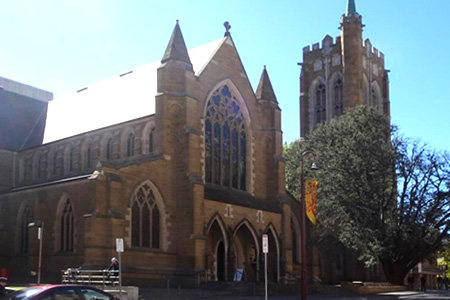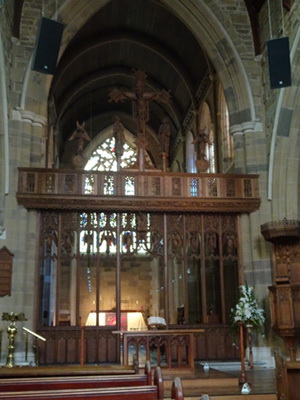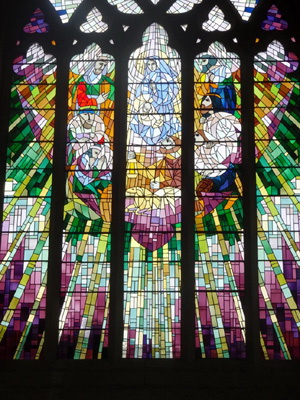| |
 |
 |
 |
| Comment on this report, or find other reports. |
 |
| Our Mystery Worshippers are volunteers who warm church pews for us around the world. If you'd like to become a Mystery Worshipper, start here. |
 |
| Find out how to reproduce this report in your church magazine or website. |
|
|
| 3144: St David’s Cathedral, Hobart, Tasmania, Australia |
 |
 |
 |
Mystery Worshipper: Tukai.
The church: St David’s Cathedral, Hobart, Tasmania, Australia.
Denomination: Anglican Church of Australia, Diocese of Tasmania.
The building: St David’s Cathedral is a classic Sandstone Victorian Neo-Gothic style church, complete with bell tower.
This is the third building of this name in Hobart, which is quite a turnover since European settlement began here only in 1803. The original convict-built wooden building burnt down and a smaller stone one was built in 1823. It made way for the present building, designed by the Englishman GF Bodley, champion of the Decorated Gothic style, especially keen on rood screens and bell towers. It dates mainly from 1868, though the bell tower and cloisters were added later – completed in 1936. A feature is the fine woodwork in the interior, in particular the rood screen, the pulpit, and the parquetry floor. There is also a full array of stained glass windows, mostly from late 19th and early 20th century, contrasting with a fine modern west window depicting the nativity, which is spectacular on a sunny afternoon. The cathedral is used for occasional state services in Hobart, such as after major bush fires. There is a small cathedral close, which offers an outdoor place of peace in the city. A feature of the cloisters (between the nave and the bell tower) is a set of small stained-glass windows of prominent churchmen, including one of John Wesley (surprising other than in a Methodist church).
The church: They hold a variety of midweek services, including morning prayer, communion for mothers and singles, traditional Prayer Book communion followed by a luncheon, and a healing service. There are two eucharistic celebrations each Sunday, plus evening prayer (or choral evensong once each month). They are also home to a Persian speaking community.
Their Friday Forum, featuring guest speakers, is (quoting from their website) an "occasional opportunity to consider interesting, topical and sometimes controversial ideas." They sponsor Cross-City Youth, (again quoting from their website) "a time for young people to develop friendships, to have fun and learn about Jesus."
The neighbourhood: Hobart is the state capital of Tasmania, which is an island to the south of the Australian mainland. Tasmania’s first European settlement was in 1803 as a giant gaol for British convicts, as an outpost of Sydney (Botany Bay). Convict transportation ceased in 1853, with Hobart quietly prospering as a port for the free settlers, who were mainly farmers. Tasmania is the most English of the Australian states, in both climate and demography.
St David's is in the centre of town, just near the docks for the beautiful deep-water harbour (the estuary of the Derwent River) , the museum and art gallery, the state Parliament House, the main shops and offices, and most of the other tourist attractions of the town. It is surrounded by other fine looking 19th century buildings.
The cast: The Very Revd Richard Humphrey, dean, was the preacher. The celebrant was the Revd Louise Orpe.
The date & time: First Sunday in Lent, 5 March 2017, 10.00am [Editor's note: This report was filed 11 April 2017].
What was the name of the service?
Holy Communion.
How full was the building?
The central part of the nave was about one-half full – about 200 people in all.
Did anyone welcome you personally?
We got a smile and “hello” from a sidesman handing out service booklets, and again from the older lady already in the pew when we sat down.
Was your pew comfortable?
Comfortable enough.
How would you describe the pre-service
atmosphere?
Fairly quiet, though not silent.
What were the exact opening words of the
service?
“Welcome to St David’s on this first Sunday in Lent. The words of the first hymn and the rest of the service are on the booklet.”
What books did the congregation use during the
service?
No books, but [as the dean said] all the words of the hymns and the service were in the booklet. The liturgy was in fact Holy Communion: Second Order from A Prayer Book for Australia.
What musical instruments were played?
The organ, a Bishop and Starr instrument installed in 1874, enlarged in 1909 and again in 1916 by George Fincham & Sons, rebuilt in 1958 by JW Walker & Sons, and substantially renovated by Gibbs & Thomson in the early part of this century. It was played softly to accompany the choir but more loudly to support congregational hymn singing.
Did anything distract you?
I spent some time trying to work out who were the other figures depicted in the rood screen apart from Christ on the cross; the lighting and distance made this a challenge. A couple of pews in front of us sat two young women with a small baby. The baby sat happily on the arms, shoulders, and knees of one of the women, but it was the other one who suckled it when it grew restless! In fact the baby spent time later in the arms of several other congregation members, which speaks well of them as a community.

Was the worship stiff-upper-lip, happy clappy, or
what?
Middle-of-the-road Anglican, with the bulk of the service said rather than sung, although a fine choir added touches appropriate to a cathedral (well sung psalm and some of the responses). Although there is a high altar and sanctuary, communion was taken from an altar in front of the rood screen; only the choir sat beyond that. Although the priests were robed, there was no incense. Not every Anglican in Australia is a Sydney Anglican!
Exactly how long was the sermon?
15 minutes (main sermon) plus 8 minutes for the separate and memorable All Age Talk earlier in the service.
On a scale of 1-10, how good was the preacher?
8 – The All Age Talk was exceptionally memorable. Patting his somewhat rounded body, the dean asked what do we need to do to get into shape. Wandering down the aisle, he solicited answers from children (standard practice in many churches, where this part of the service is called the “children’s address”). But since only a few children were present, he also addressed questions to named adult members of the congregation (“What do you think, Bob?”). He followed a tangled line of answers from “exercise” through to “to prepare to exercise we need to get suitably dressed.” At which point, he stripped off his robes to reveal the running singlet and shorts that he had on underneath! He then claimed that getting ready physically to exercise was like getting ready spiritually to exercise with God, thus introducing his Lenten theme of the need to get ourselves spiritually into shape. Pulling his robes back on was the cue for a surprisingly large number of children and adults to leave for Sunday school (some children had been lurking in the pews behind me).
In a nutshell, what was the sermon
about?
The main sermon, which the dean preached fully robed from the pulpit later in the service, followed the same Lenten theme, but drawing more specifically on the Bible readings for the day. We all fall short of the glory of God, and thus need help (the grace of God) to put ourselves right. The temptation of Jesus in the wilderness reminds us of the way in which we are often distracted from getting and keeping ourselves in shape spiritually.
Which part of the service was like being in
heaven?
The choir (adult men and women) sang beautifully and with very clear articulation the psalm and Kyrie, well supported by an organ played so softly that I barely noticed it at the time.
And which part was like being in... er... the other place?
I was concerned that as the dean walked the aisle during his All Ages Talk looking for suckers, he might call on me to respond.
What happened when you hung around after the service looking lost?
We were all invited to morning tea in the annex. You couldn’t get out the main (west) door without passing a line of greeters (including the two priests). In any case I paused by the bookstall, looking for a brochure about the building. Seeing this, one of the helpers came to give me one and to chat about that subject. We then wandered via the cloisters to morning tea, where there was plenty more chat.
How would you describe the after-service
coffee?
Refreshing tea and coffee were both offered in cups. There were also some slices and biscuits on the table.
How would you feel about making this church your regular (where 10 = ecstatic, 0 = terminal)?
8 – A good feeling of community pervaded, similar to what we enjoyed years ago in a cathedral in a similarly sized city.
Did the service make you feel glad to be a
Christian?
Certainly.

What one thing will you remember about all this in seven days' time?
The dean’s strip-tease. |
|
|
 |
 |
 |
| We rely on voluntary donations to stay online. If you're a regular visitor to Ship of Fools, please consider supporting us. |
 |
 |
 |
| The Mystery Pilgrim |
 |
| One of our most seasoned reporters makes the Camino pilgrimage to Santiago de Compostela in Spain. Read here. |
 |
 |
 |
| London churches |
 |
| Read reports from 70 London churches, visited by a small army of Mystery Worshippers on one single Sunday. Read here. |
| |
|
|
|
|


